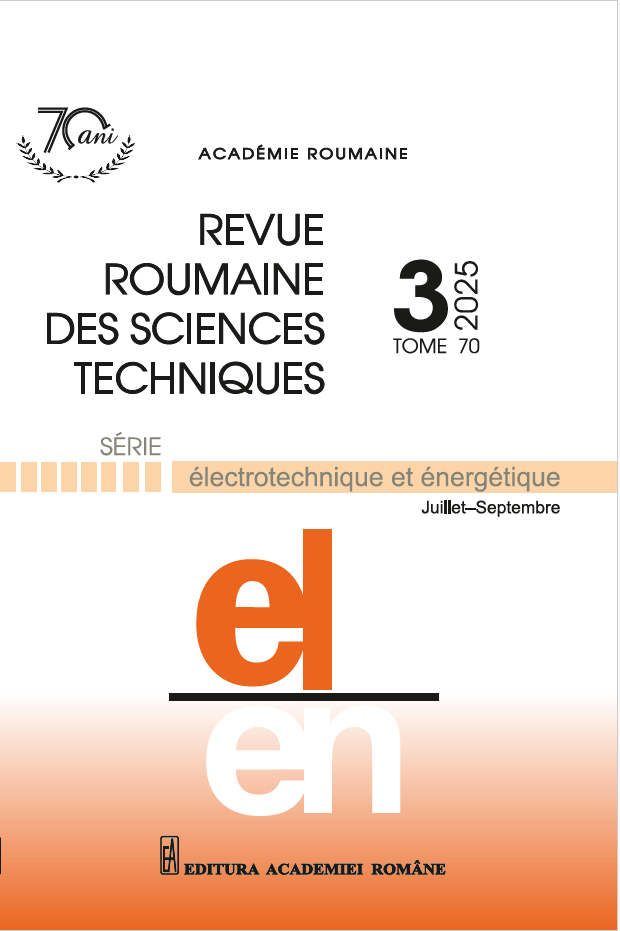COMMUNICATION ADAPTATIVE SYNERGÉTIQUE ET LONGUE PORTÉE LORA POUR LE CONTRÔLE DU QUADROTOR ET LA LOCALISATION INTÉRIEURE PAR ANALYSE D'INTERVALLES
DOI :
https://doi.org/10.59277/RRST-EE.2025.3.17Mots-clés :
New approach based on the use of RSSI (Received Signal Strength Indication) combined with LoRa (Long Range) communication technology has been developed to locate a droneRésumé
Dans cet article, une nouvelle approche basée sur l'indication de la force du signal reçu (RSSI) combinée à la technologie de communication longue portée (LoRa) a été développée pour localiser un drone. De plus, une analyse d'intervalle a été introduite pour améliorer la précision de la localisation et la fiabilité du système. Cette approche implique la prise en compte de plusieurs mesures RSSI sur des intervalles de temps définis. Le quadrirotor est contrôlé par un système de contrôle adaptatif basé sur la passivité de l'ASC du système. En combinant RSSI avec la technologie LoRa, l'analyse d'intervalle et le contrôle de l'ASC basé sur la passivité, notre approche offre une solution robuste et efficace pour le contrôle et la localisation des drones. Cette méthodologie pourrait être appliquée à une multitude de scénarios réels, offrant des avantages significatifs en termes de sécurité, d'efficacité opérationnelle et de performance globale des systèmes de drones.
Références
(1) C. Kheireddine, A. Yassine, S. Fawzi, M. Khalil, A robust synergetic controller for Quadrotor obstacle avoidance using Bézier curve versus B-spline trajectory generation, Intelligent Service Robotics, 15, pp. 143–152 (2022).
(2) L. Crupi, A. Giusti, D. Palossi, High-throughput visual nano-drone to nano-drone relative localization using onboard fully convolutional networks, In Proc. IEEE Int. Conf. Robot. Autom. (ICRA) (2024).
(3) P. Nguyen, T. Kim, J. Miao, D. Hesselius, Towards RF-based localization of a drone and its controller, In Proc. ACM DroNet’19, Seoul, Republic of Korea (2019).
(4) B. Kaplan, I. Kahraman, A.R. Ekti, S. Yarkan, A. Görçin, M.K. Ozdemir, H.A. Çırpan, Detection, identification, and direction of arrival estimation of drone FHSS signals with uniform linear antenna array, IEEE Access, 9, pp. 152057–152069 (Nov. 2021).
(5) H. Feroura, F. Krim, B. Talbi, A. Laib, A. Belaout, Sensorless field-oriented control of current source inverter fed induction motor drive, Rev. Roum. Sci. Techn. – Électrotechn. et Énerg., 63, 1, pp. 100–105 (2018).
(6) P.-S. Wang, C.-H. Lin, C.-T. Chuang, Real-time object localization using a fuzzy controller for a vision-based drone, Inventions, 9, pp. 14 (2024).
(7) S. Ghosh, T.K. Saha, Progressive step maximum power tracker for cascaded inverter induction motor drive, Rev. Roum. Sci. Techn.–Électrotechn. et Énerg., 69, 1, pp. 3–8 (2024).
(8) A.P. Brîncoveanu, R. Plămănescu, A.-M. Dumitrescu, M. Albu, Voltage variability assessment in power systems, Rev. Roum. Sci. Techn.–Électrotechn. et Énerg., 69, 2, pp. 171–176 (2024).
(9) S. Latreche, B. Babes, A. Bouafassa, Design and real-time implementation of synergetic regulator for a DC-DC boost converter, Rev. Roum. Sci. Techn. – Électrotechn. et Énerg., 69, 3, pp. 305–310 (2024).
(10) N. Nurelmadina, M.K. Hasan, I. Memon, R.A. Saeed, K.A. Zainol Ariffin, E.S. Ali, et al., A systematic review on cognitive radio in low-power vast area network for industrial IoT applications, Sustainability, 13, 1, p. 338 (2021).
(11) K.F. Haque, A. Abdelgawad, V.P. Yanambaka, K. Yelamarthi, LoRa architecture for V2X communication: An experimental evaluation with vehicles on the move, Sensors, 20, 23, pp. 6876 (2020).
(12) T. Jian Ng, N. Kumar, M. Othman, LoRa-based indoor positioning in dynamic industrial environments using deep Gaussian process regression and temporal-based enhancements, IEEE Access, 12, pp. 165298–165313 (2024),
(13) E.D. Ayele, C. Hakkenberg, J.P. Meijers, K. Zhang, N. Meratnia, P.J. Havinga, Performance analysis of LoRa radio for an indoor IoT application, 2017 International Conference on Internet of Things for the Global Community (IoTGC), pp. 1–8 (2017).
(14) M.I. Mahmud, A. Abdelgawad, V.P. Yanambaka, K. Yelamarthi, Packet drop and RSSI Evaluation for LoRa: An indoor application perspective, IEEE 7th World Forum on Internet of Things (WF-IoT), pp. 913–914 (2021).
(15) K. Mokhtari, M. Abdelaziz, Passivity-based simple adaptive control for quadrotor helicopter in the presence of actuator dynamics, IEEE 8th International Conference on Modelling, Identification and Control (ICMIC 2016), pp. 15-17 (Nov 2016).
(16) K. Mokhtari, A. Elhadri, M. Abdelaziz. A passivity-based simple adaptive synergetic control for a class of nonlinear systems, Int. J. Adapt Control Signal Process, pp.1–15 (2019).
(17) M. Filić, R. Filjar, M. Ševrović, Expression of GNSS positioning error in terms of distance, Promet – Traffic & Transportation, 30, 3, pp. 305–310 (2018).
(18) G. Tian, D. Pjanić, X. Cai, B. Bernhardsson, F. Tufvesson, Attention-aided outdoor localization in commercial 5G NR systems, IEEE Transactions on Machine Learning in Communications and Networking (2024).
Téléchargements
Publiée
Numéro
Rubrique
Licence
(c) Copyright REVUE ROUMAINE DES SCIENCES TECHNIQUES — SÉRIE ÉLECTROTECHNIQUE ET ÉNERGÉTIQUE 2025

Ce travail est disponible sous licence Creative Commons Attribution - Pas d'Utilisation Commerciale - Pas de Modification 4.0 International.


